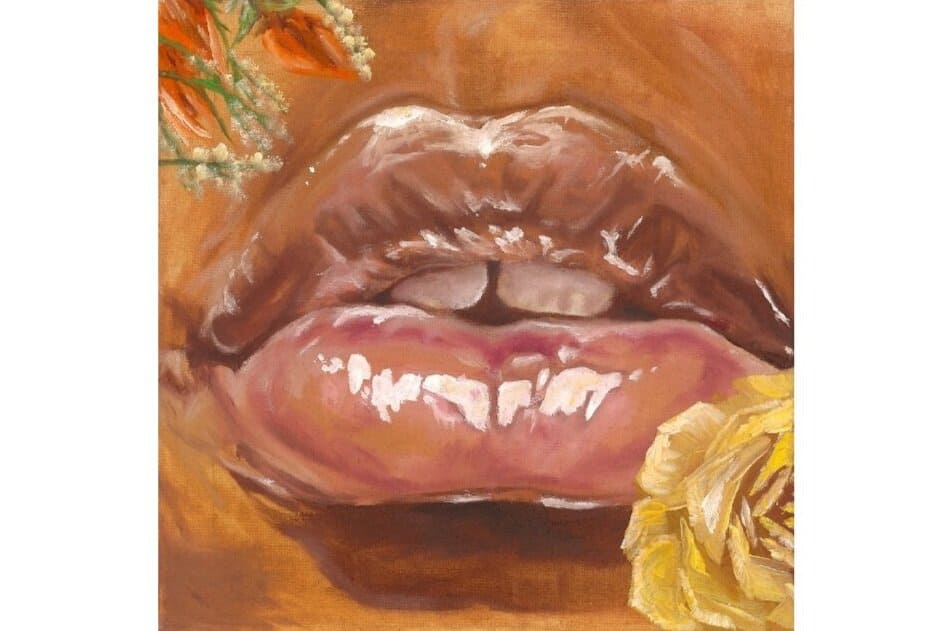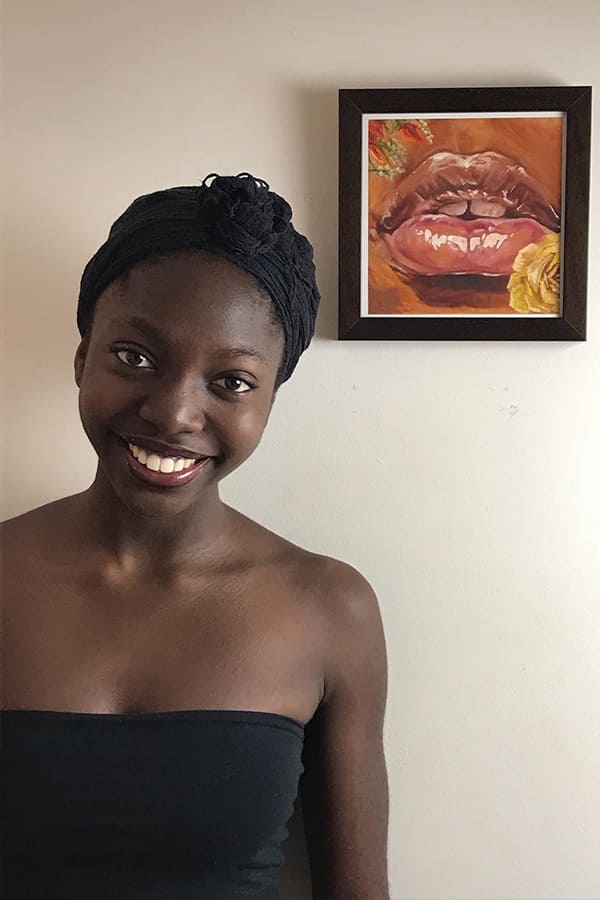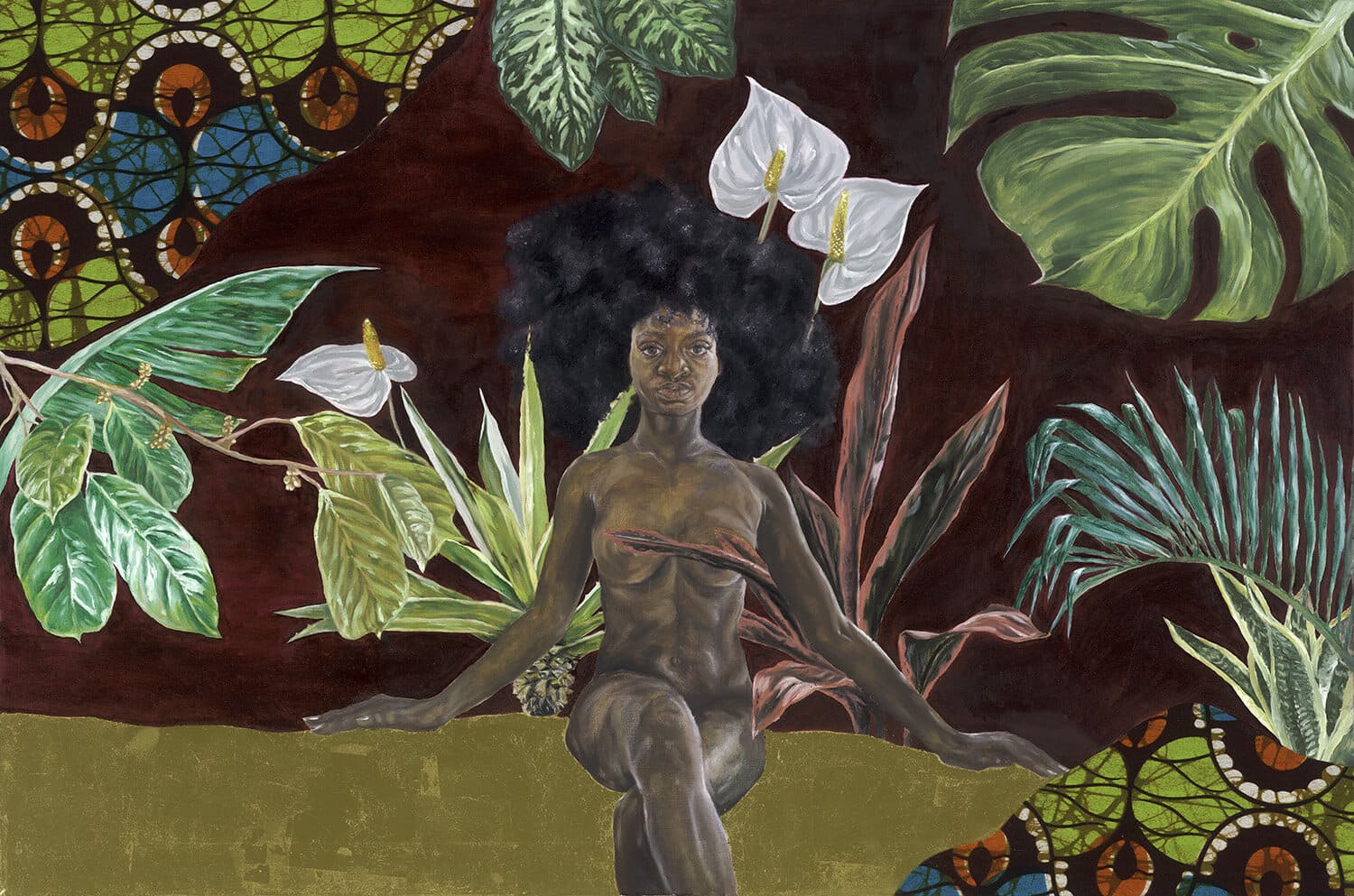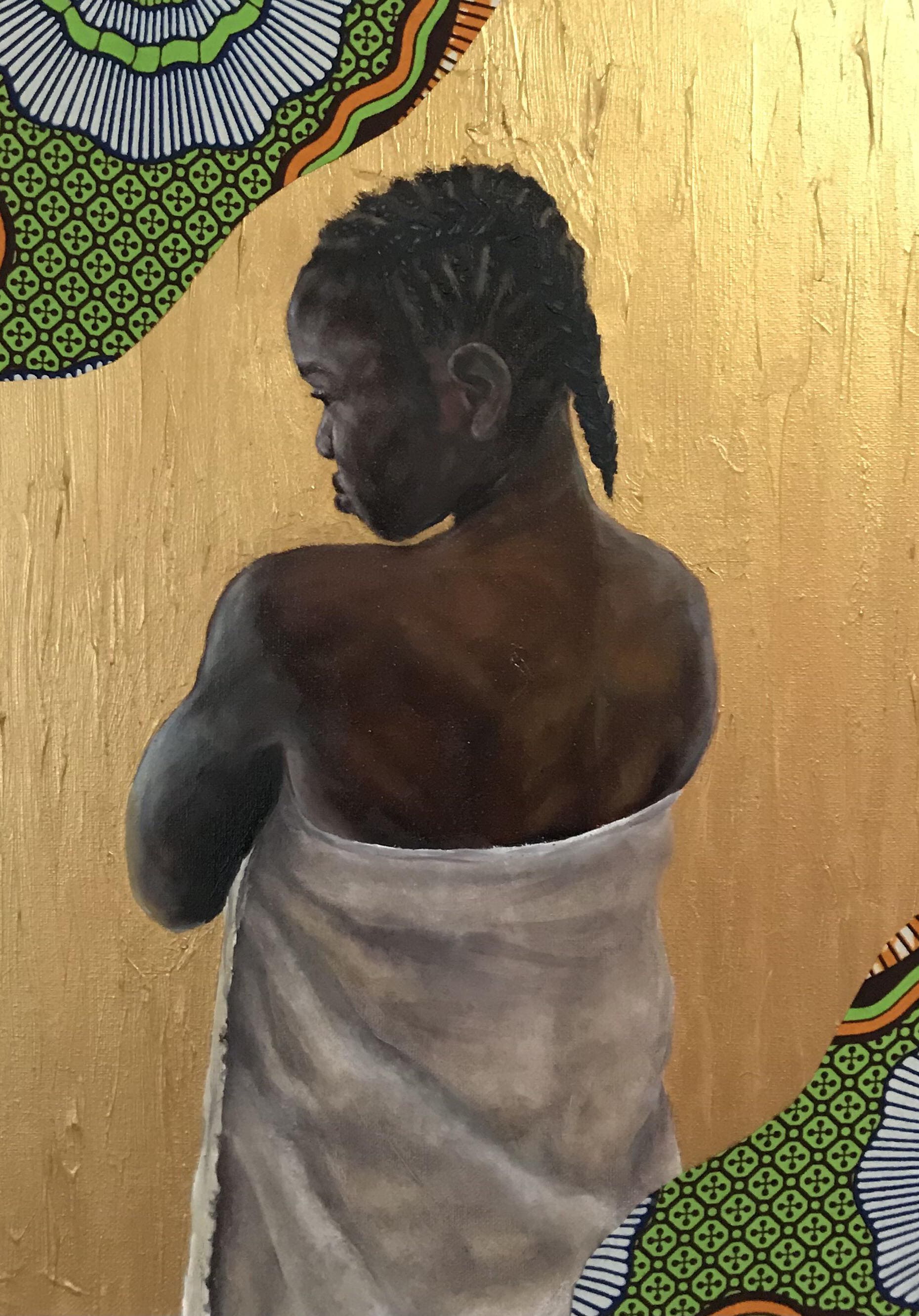Ruhkia Johnston is an artist intent on encouraging conversations about culture and heritage through the use of oil paints, African fabrics, and the occasional incorporation of gold leaf. Creating paintings that elicit an emotional response, and have the ability to resonate, Johnston’s chosen form of expression focuses on connections between humans and nature, and the empowerment of Black women. I spoke to the artist about themes of introspection, the significance of utilising African Wax Print Fabrics, the healing power of nature, and her creative process.
NAHUEL CONTRERAS What is your artistic background? Have you always gravitated towards figurative art? RUHKIA JOHNSON AI have always been someone who likes to pay close attention to the seemingly small things. As an empath, I have always ‘felt’ my surroundings. I started painting during my GCSE’s and I wasn’t expecting it to be my ‘thing’, I just chose it because I wanted a break from my other subjects! As the years went by, I got better, and I started to use my art to explore. In my artwork you will see hints of my African-Caribbean culture, and also the elegance of nature.
Although landscape paintings are beautiful, there is just something about carefully studying the textures and tones of human skin that is equally as fruitful. Looking back, I have always found my style was more suited to figurative art. NC What is your creative process when painting?
 RJ
My creativity is driven by outside walks and random daydreams. I wouldn’t really say I have a consistent creative process. Hopefully, some sort of routine will develop, but as of now, it changes per piece, and is decided by what goes on around me. I usually have a very loose idea of what I want to achieve- sketches, a few sentences, and photos. Next, I turn on some music, burn some incense, and then simply start. I am guided by what I want to adapt in that moment, and this feels most organic to me.
NC
Who are your influences, and how do they impact your practice?
RJ
My influences include many jazz and soul singers, my mother and… myself. From Ella Fitzgerald to Amy Winehouse, all these timeless singers accompany me while I paint. They allow me to let go of the things on my mind, and then the painting in front of me comes into view. My mother, she is just an amazing woman. Watching her start her own African print baby clothes business (AfroPuff Ltd), and seeing it grow from scratch has shown me that there should be nothing holding me back. If I want to do something, I can do it, even if it requires extra work.
RJ
My creativity is driven by outside walks and random daydreams. I wouldn’t really say I have a consistent creative process. Hopefully, some sort of routine will develop, but as of now, it changes per piece, and is decided by what goes on around me. I usually have a very loose idea of what I want to achieve- sketches, a few sentences, and photos. Next, I turn on some music, burn some incense, and then simply start. I am guided by what I want to adapt in that moment, and this feels most organic to me.
NC
Who are your influences, and how do they impact your practice?
RJ
My influences include many jazz and soul singers, my mother and… myself. From Ella Fitzgerald to Amy Winehouse, all these timeless singers accompany me while I paint. They allow me to let go of the things on my mind, and then the painting in front of me comes into view. My mother, she is just an amazing woman. Watching her start her own African print baby clothes business (AfroPuff Ltd), and seeing it grow from scratch has shown me that there should be nothing holding me back. If I want to do something, I can do it, even if it requires extra work. Finally, I would say myself, although it is not because I’m vain! Reflecting on what I have overcome and achieved in the past has enabled me to have a deeper understanding of how to make sure my creative practice is still fundamentally ‘me’. NC The rich and significant textile craftsmanship of African Wax Print Fabrics is celebrated in your paintings. Tell me more about how you elevate the cultural and aesthetical qualities of these textiles within your paintings? RJ Wax print fabrics became a symbol of cultural celebration and independence when European Colonialism came to an end. I use these textiles because it is a subtle way of intertwining my heritage and art. Each different patten represents a different story, a different personality.
Growing up, I was always surrounded by African print textiles. My grandma sewed dresses for me, and materials hung on the living room walls. Choosing to incorporate these fabrics into my art was probably not a conscious decision. However, the more I dig into the meanings and beauty of these patterns, the more I realise that they really do belong in my work. My art features wavy material cut-outs that harmonise with the beauty of the painted figures, and root each piece in African-Caribbean culture. The unique designs and vibrant colours represent individuality and inner strength, attributes which I see in my community.
 NC
Cultural referencing is abundant throughout your work. How does your own cultural identity influence your work?
RJ
I don’t actively use my own cultural identity as an influence, it is fundamentally a part of me, and so references end up being conveyed in my artwork regardless. I enjoy the fact that my art pays subtle homage to where I come from. My parents are from Jamaica and Nigeria, so I am lucky to experience the beauty and richness of both cultures. I was brought up to be proud of the colour of my skin; the figures I paint exemplify this sense of comfort within oneself.
NC
Burnt sienna, yellow ochre, varied hues of green; your paintings utilise the visual impact of colour combinations to communicate. How important is the use of colour to your practice?
RJ
I haven’t yet had the chance to delve into colour theory as deeply as I would like to, although I know that having that knowledge would make so many of the things that I do easier. Currently, it is solely about how the colours make me feel. It is important to me that the background colours of my paintings work well with the African wax print fabric. Once those colours are present, the piece finally comes together in its own way.
NC
Your art focuses heavily on the human form. Pose, composition, expression, are all utilised to provoke dialogue. Tell me more about your artistic focus on technique and composition?
RJ
The painted figures can be seen deep in thought or staring meaningfully into the distance. In my piece ‘Our Garden’, the lady is poised gracefully upon gold, and the plants gently surround her as she looks into the eyes of the spectator. What I wanted to achieve is the effect that she has an individual story that manifests itself in innumerable ways within the mind of the viewer. The subject’s gaze allows me to convey the themes of reflection and introspection that run through my collection.
NC
Cultural referencing is abundant throughout your work. How does your own cultural identity influence your work?
RJ
I don’t actively use my own cultural identity as an influence, it is fundamentally a part of me, and so references end up being conveyed in my artwork regardless. I enjoy the fact that my art pays subtle homage to where I come from. My parents are from Jamaica and Nigeria, so I am lucky to experience the beauty and richness of both cultures. I was brought up to be proud of the colour of my skin; the figures I paint exemplify this sense of comfort within oneself.
NC
Burnt sienna, yellow ochre, varied hues of green; your paintings utilise the visual impact of colour combinations to communicate. How important is the use of colour to your practice?
RJ
I haven’t yet had the chance to delve into colour theory as deeply as I would like to, although I know that having that knowledge would make so many of the things that I do easier. Currently, it is solely about how the colours make me feel. It is important to me that the background colours of my paintings work well with the African wax print fabric. Once those colours are present, the piece finally comes together in its own way.
NC
Your art focuses heavily on the human form. Pose, composition, expression, are all utilised to provoke dialogue. Tell me more about your artistic focus on technique and composition?
RJ
The painted figures can be seen deep in thought or staring meaningfully into the distance. In my piece ‘Our Garden’, the lady is poised gracefully upon gold, and the plants gently surround her as she looks into the eyes of the spectator. What I wanted to achieve is the effect that she has an individual story that manifests itself in innumerable ways within the mind of the viewer. The subject’s gaze allows me to convey the themes of reflection and introspection that run through my collection.I really feel that honesty with oneself is an important part of being an artist, especially when painting people. When painting (realism), it’s tempting to make everything look symmetrical but that isn’t always the reality. Once artists allow themselves to look at their subjects honestly, seeing unique flaws, their art will show the truth and accept that not everything in life has to be perfect.
Regarding composition, I have never really thought about it too much. I seem to be drawn to painting a single person in the middle of the canvas, although I am open to changing this in the future. NC Your representations of the female body diverges from the patriarchal gaze in art that views the female body as an object of desire, and instead you empower affirming narratives around the sociocultural experiences of Black women. How important is it to subvert the expectations of race, gender, and representation from the history of portraiture?
 RJ
To be honest, I still have a lot to learn about the history of portraiture. However, dependent on the gender of the artist or viewer, the female nude carries a different weight. I have received a few comments about the lady in my paintings not being covered up enough. I am not allowed to advertise ‘Our Garden’ on many sites, and I have seen the nervous and uncomfortable glances when I show some people this piece. There is still a way to go when it comes to subverting expectations.
RJ
To be honest, I still have a lot to learn about the history of portraiture. However, dependent on the gender of the artist or viewer, the female nude carries a different weight. I have received a few comments about the lady in my paintings not being covered up enough. I am not allowed to advertise ‘Our Garden’ on many sites, and I have seen the nervous and uncomfortable glances when I show some people this piece. There is still a way to go when it comes to subverting expectations. I wanted the lady in ‘Our Garden’ to appear quietly confident, and almost regal amongst the nature. Regardless of her race, her nudity is her own. Although I chose to depict a black female, I wanted to ensure that my overall message transcends race or gender, and communicates with people from any background. You are seeing her in a space which she has cultivated. However, just for this moment, she is letting us in. Just for this moment, the garden is hers, yours and mine. NC Is your art a social commentary? RJ When I started, I only knew what I wanted to see more of in the art world. The more exposure my work has received, the more people started asking me for meaning. Really, I was just painting, that’s all it was. The older I have gotten, the more I have come to understand just how important of a part art plays in bringing new perspectives about. Only recently, have I tried to paint more consciously, and this has helped me to connect with more people.
We spend a lot of time fighting for justice, which is incredibly important, but right now I want my art to be a respite from our current political and social climate. This period has not been great, but it has awarded many of us with time for introspection. We must check in on ourselves and one of the ways this is achieved is by expressing ourselves with art, or simply looking at art that calms and resonates with us. NC As Audre Lorde said, “Caring for myself is not self-indulgence. It is self-preservation, and that is an act of political warfare.” Your works ‘Our Garden’ and ‘Finding My Diaspora’ are examples of how you as an artist explore rest, self-love, care, comfort, and wellness. What value does introspection have in your work? Do you feel it is imperative to prioritise self-care as a form of resistance? RJ When Audre Lorde wrote about self-care, I felt that she spoke of being true to yourself even when everyone around you is different. Introspection is so powerful because when I paint, I want my art to be an extension of my mind. One of the things I have learned is to use my art as a form of self-care. Whenever, I’m feeling unsure of myself, which happens very often, or I feel a bit down, I pick up my brush, and create to ground myself again.
Personally, I don’t even label my own self-love as anything. Like when practising mindfulness, I am trying to have this comfort running in the back of my mind throughout the day. If you use self-care as a form of resistance, go for it, you are strong. If you use self-care as a rest from the resistance you practice in other parts of your life, go for it, you are strong.
 NC
You say that the acrylic gold negative space in “Power of Reflection” is emblematic of the strength emanating from the subjects’ mind. How important is communicating a narrative within your art?
RJ
The main concept for my work is letting viewers deduce their own interpretation. I get asked my own opinion a lot, so I do speak about it, although I want everyone’s thoughts to remain individual.
NC
You say that the acrylic gold negative space in “Power of Reflection” is emblematic of the strength emanating from the subjects’ mind. How important is communicating a narrative within your art?
RJ
The main concept for my work is letting viewers deduce their own interpretation. I get asked my own opinion a lot, so I do speak about it, although I want everyone’s thoughts to remain individual. Although, my art might not be to everyone’s taste, I wish for it to communicate with us all. I share one single narrative but there’s nothing I love more than when someone sends me a paragraph of what they felt and understood about the work I have created. It may or may not be completely different from what I initially thought, but that is the beauty of individualism. That is also the beauty of a community open to discussing perspective.
 NC
Why is engaging with the healing power of nature so important to your art?
RJ
Nature is so intriguing. The natural world was here before us and will most likely be here after us, yet many pretend that we are better. My art promotes connectivity between humans and plants. On my canvas, both humans and nature occupy the space to represent the harmony that can be brought about when humans simply respect the nature, which quietly resides beside us.
NC
What are you currently working on?
RJ
The piece I am working on is still unnamed. I wanted to challenge myself to a big canvas to finally break free from the artist’s block I had been facing. I am not too sure of where it’s going but I know that I want to reconnect with a version of myself that has been lost for a while. The words ‘peace’ and ‘strength’ have been circling my mind so that’s what I want to emulate. I am really excited about it!
NC
Why is engaging with the healing power of nature so important to your art?
RJ
Nature is so intriguing. The natural world was here before us and will most likely be here after us, yet many pretend that we are better. My art promotes connectivity between humans and plants. On my canvas, both humans and nature occupy the space to represent the harmony that can be brought about when humans simply respect the nature, which quietly resides beside us.
NC
What are you currently working on?
RJ
The piece I am working on is still unnamed. I wanted to challenge myself to a big canvas to finally break free from the artist’s block I had been facing. I am not too sure of where it’s going but I know that I want to reconnect with a version of myself that has been lost for a while. The words ‘peace’ and ‘strength’ have been circling my mind so that’s what I want to emulate. I am really excited about it!